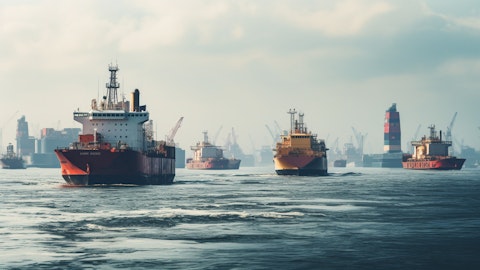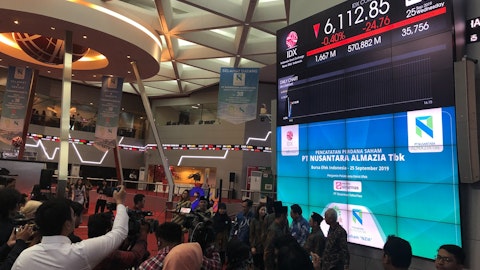David Smith: So one of the themes for the offshore rig market has been extending contract lead times. I’m curious what you’re seeing on that front, right? So if an operator signs a drillship to start working in April ’25, are they looking to sign vessel support, too, or is that something they’ll just worry about later?
Piers Middleton: Yes. Hi, David, it’s Piers again. So I’m going to — I mean, we’re seeing, obviously, our operators or our customers looking to fix that for the rigs. I would say, I think I might have mentioned this on the last call. We tend to still see they leave it a little bit late for us, which works to our advantage in many ways because it tightens up the market because we can go slightly shorter. But no, there are certainly a few of, some of the more forward-thinking customers who are starting to realize that there’s a lack of supply on the larger platform, supply vessels in particular. So they’re coming to talk to us a little bit. But no, generally they haven’t — the majority haven’t really caught on still. So that works to our advantage. So we’re able to come in and push the rates. But no, the focus tends to be on the rigs rather than on the boats still a little bit.
David Smith: Appreciate that. And sorry if I missed it, but regarding the leading edge rate. Is that kind of the same framework given on prior quarters, right? That’s the average rate of new contracts signed, representative of the fleet mix. And any color on average duration.
Piers Middleton: Yes, that’s correct. And average duration last quarter was nine months on contracts — on the new contract signed.
David Smith: Perfect. I’ll circle back in the queue. Thank you.
Operator: Our next question comes from the line of Fredrik Stene with Clarksons Securities. Please go ahead.
Fredrik Stene: Hello again. One thing I wanted to circle back on. You mentioned in your prepared remarks about, or I think it was you, about the fleet being older and older and a fair amount actually hitting that 25-year-old limit over the next 10-ish years. Are you currently, in what I would consider a very strong market already, seeing that operators are changing their requirement, or are they having less stringent requirement today in terms of age, crews, flags, again depending on region compared to what they have before just because they’re in a situation where securing vessels is hard, at least periodically, or are they still following preferences that they might have had historically strictly? Thanks.
Piers Middleton: Hi, Fredrik, it’s Piers again. There is definitely some relaxation towards age, but with that comes the expectation of our customers is they want to work with a Tier 1 operator who can operate safely and has some control of its supply chain and maintenance and all that side. And there’s not a huge amount of our competitors, perhaps, who have that sort of strength that we have. So it comes as a sort of twofold discussion that they have no choice but to relax a little bit on some of their age requirements. But with that comes a lot of other expectations from the customer base that they expect to be supported by a Tier 1 operator like Tidewater. So yes, there is some relaxation, but they don’t really have much choice on that, and some customers are more relaxed than others. But yes.
Fredrik Stene: Just a quick follow-up on that. No, that’s super helpful, Piers. For — let’s say that you and some competitor have but a rig — sorry, not a rig, but a vessel that’s a bit on the old side compared to what an operator would prefer. Are you, with the Tidewater system backing that bid, able to actually get the preference for the contract and also maybe a premium on that contract versus what the less trustworthy vessel owner would get on a similar vessel just because you are part of the system that you’re part of?
Piers Middleton: I sincerely hope so. Yes, you pay for a quality operator like Tidewater, so we charge appropriately.
Fredrik Stene: Super. Thank you so much again for taking round two of the questions. I wish you all a good weekend when that time comes. Thanks.
Quintin Kneen: You too. Thanks.
Operator: Our next question comes from the line of David Smith with Pickering Energy Partners. Please go ahead.
David Smith: Hey, I had that same question, but I’ll ask one more. Thanks for letting me back in. So I really appreciate the commentary about the constraints for new vessel supply and just thinking about other angles to address growing demand. When we were looking through the list of laid-up vessels across the industry, one thing that struck me was a large number of vessels that looked like they were owned by entities that we can’t tell are active vessel managers. And maybe that data is wrong or I’m missing something, but I’m curious if you’ve seen anything notable on the vessel M&A front with laid-up vessels being acquired by active managers looking to grow their fleets.
Piers Middleton: Hi, it’s Piers again. No, we haven’t really. I mean, most of the viable acquisitions and one-ship type of deals were done probably in sort of 2022 by people picking up vessels. Our view is that what’s stacked and laid up today has been there for five-plus years and is basically obsolete and won’t be coming back into the marketplace. One or two, I’m sure, will make their way back, but the majority of what you see stacked and laid up has been there for a long, long time, and it’s going to be very, very difficult to bring those ships back out into the marketplace.
David Smith: Perfect. That’s all for me. Thank you.
Operator: Our next question comes from the line of Don Crist with Johnson Rice. Please go ahead.
Don Crist: Morning, gentlemen. Just one balance sheet question for me. A lot of other topics have been covered. But as we look at free cash flow allocation, should we think or model some debt repayment in that or would you rather just build cash and kind of leave that debt on the balance sheet as you search for M&A and other kind of uses for that free cash flow?





